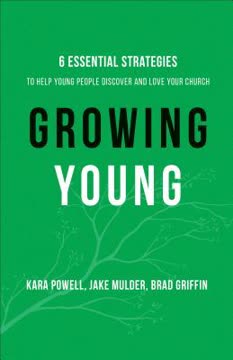Key Takeaways
1. Churches must embrace six core commitments to engage young people effectively
Churches that grow young are eschewing behavior-based gospels like MTD and the Golden Rule by making three key shifts in how they describe the message of Jesus.
The Growing Young Wheel. Churches that effectively engage 15- to 29-year-olds share six core commitments:
- Unlock keychain leadership
- Empathize with today's young people
- Take Jesus' message seriously
- Fuel a warm community
- Prioritize young people (and families) everywhere
- Be the best neighbors
These commitments work together to create a church culture that attracts and retains young people while helping them develop a vibrant faith. Rather than relying on flashy programs or a single charismatic leader, churches growing young focus on building authentic relationships and creating meaningful opportunities for young people to participate in all aspects of church life.
2. Unlock keychain leadership by empowering young people with responsibilities
Keychain leaders model a posture of giving away access and authority. This posture not only empowers others but also meaningfully links them to the life of the congregation.
Sharing power and responsibility. Keychain leadership involves:
- Being aware of the "keys" (capabilities, power, and access) leaders possess
- Intentionally entrusting young people with responsibilities
- Allowing young people to contribute meaningfully to church life
Effective keychain leaders are:
- Mature (not necessarily young themselves)
- Authentic and transparent
- Warm and relational
- Attentive to what matters to people
- Focused on empowering others rather than hoarding control
- Patient and committed to long-term development
By sharing leadership, churches create opportunities for young people to develop their gifts and feel valued as essential members of the community.
3. Empathize with today's young people to understand their unique challenges
Young people wrestle with three ultimate questions: Who am I? (a question of identity), Where do I fit? (a question of belonging), and What difference do I make? (a question of purpose).
Understanding extended adolescence. Today's young people face unique challenges:
- Extended adolescence (25 is the new 15, and 15 is the new 25)
- Delayed traditional markers of adulthood (marriage, career, financial independence)
- Increased stress and pressure
- Digital technology's impact on relationships
- Struggles with identity, belonging, and purpose
Churches that grow young take time to listen and understand these challenges. They create space for young people to explore their questions and doubts, offer support during transitions, and provide guidance in navigating complex cultural issues. By empathizing, churches can better address the real needs of young people and offer relevant support and teaching.
4. Take Jesus' message seriously by focusing on his life and teachings
Churches growing young are eschewing behavior-based gospels like MTD and the Golden Rule by making three key shifts in how they describe the message of Jesus.
Refocusing on Jesus. Churches growing young make three key shifts:
- Less talk about abstract beliefs, more focus on Jesus
- Less emphasis on formulas, more on the redemptive narrative
- Less about future heaven, more about life here and now
These churches help young people:
- Connect with Jesus as a person and model for life
- Understand their place in God's larger story
- Apply faith to real-world issues and everyday decisions
- Embrace challenge and sacrifice as part of discipleship
By taking Jesus' message seriously, churches offer young people a compelling vision of faith that goes beyond moralism or feel-good spirituality, addressing their deep longing for meaning and purpose.
5. Fuel a warm community that feels like family to young people
When young people in your church and community know they are needed and invited into participation just like everyone else, they sense that they play a load-bearing role in the congregation.
Creating authentic community. Warmth in churches is characterized by:
- Welcoming and accepting atmosphere
- Intergenerational relationships
- Opportunities for meaningful participation
- Space for authenticity and vulnerability
Strategies for fueling warmth:
- Prioritize relationships over programs
- Create opportunities for intergenerational connection
- Involve young people in leadership and decision-making
- Foster a culture of honesty and grace
Young people are drawn to churches where they feel known, valued, and included as full members of the community. This sense of belonging often matters more to them than polished programs or contemporary worship styles.
6. Prioritize young people and families in all aspects of church life
Churches growing young provide this vocational guidance by helping teenagers and emerging adults locate themselves and their work in light of a grand narrative.
Integrating young people everywhere. Prioritization involves:
- Allocating resources (budget, staff, facilities) to youth and family ministries
- Including young people in church leadership and decision-making
- Adapting church culture to be more welcoming to young people
- Supporting and partnering with parents in faith formation
Strategies for prioritization:
- Involve young people in worship leadership and planning
- Create mentoring relationships between generations
- Offer support for young families and single young adults
- Help young people discover their gifts and callings
By prioritizing young people and families, churches signal that they value the next generation and are committed to their spiritual growth and development.
7. Be the best neighbors by engaging positively with the surrounding culture
Churches that grow young recognize the careful dance that values both fidelity to Scripture's commands for holiness and knowing and graciously loving their neighbors.
Positive cultural engagement. Being the best neighbors involves:
- Honoring what's good in culture
- Making the world better through service and social justice
- Respecting diverse viewpoints while maintaining conviction
- Helping young people find their vocational calling
Strategies for neighborliness:
- Engage in local and global service opportunities
- Foster dialogue on challenging cultural issues
- Celebrate ethnic and socioeconomic diversity
- Support young people in pursuing purpose-driven careers
Churches that are the best neighbors help young people see how faith connects with real-world issues and empowers them to make a positive difference in their communities and beyond.
8. Listen carefully to your congregation to understand its unique context
If we don't listen to others, we are prone to a common mistake, namely, equating the health and needs of our church with the "three Bs" that have often been used to measure congregations—building, bodies, and budget.
Understanding your context. Effective listening involves:
- Gathering input from all generations, not just young people
- Paying attention to the unique needs and culture of your community
- Looking beyond surface-level metrics to understand deeper dynamics
Listening strategies:
- Conduct surveys and focus groups
- Have one-on-one conversations with diverse church members
- Analyze demographic data about your community
- Observe patterns and trends in church participation
By listening carefully, church leaders can identify the specific obstacles and opportunities in their context, allowing them to tailor their approach to growing young.
9. Develop a shared vision through stories of future hope
Vision is "shared stories of future hope."
Crafting compelling vision. Effective vision-casting involves:
- Creating stories that illustrate the church's desired future
- Connecting individual stories to God's larger narrative
- Inspiring action and commitment across generations
Elements of powerful vision stories:
- Concrete examples of how young people will be engaged
- Clear connection to the church's mission and values
- Emotional appeal that resonates with diverse members
- Achievable goals balanced with faith-filled aspirations
By developing shared stories of future hope, churches can unite their congregation around a common vision for growing young and motivate members to take action.
10. Implement change gradually through experimentation and disciplined attention
Churches that grow young successfully fight against distractions or other pitfalls that threaten to derail them by maintaining disciplined attention.
Managing change effectively. Implementing change requires:
- Starting with small experiments on the margins
- Creating a "holding environment" that balances discomfort and safety
- Maintaining focus on long-term goals despite setbacks
Strategies for change management:
- Form a diverse team to guide the growing young process
- Identify and celebrate small wins along the way
- Address conflicts and resistance with grace and patience
- Regularly evaluate progress and adjust strategies as needed
By taking a gradual, experimental approach and maintaining disciplined attention, churches can navigate the challenges of change and successfully implement the core commitments needed to grow young.
Last updated:
FAQ
1. What is Growing Young by Kara Powell about?
- Church vitality focus: Growing Young explores how churches can effectively engage and retain young people ages 15 to 29, fostering vibrant, intergenerational faith communities.
- Research-based insights: The book is grounded in a four-year research project by the Fuller Youth Institute, studying over 250 U.S. churches that are successfully “growing young.”
- Six core commitments: It introduces six essential strategies that help churches become more welcoming, relevant, and impactful for young people.
- Contextual application: The authors emphasize that these principles must be adapted to each church’s unique context for lasting change.
2. Why should I read Growing Young by Kara Powell?
- Addresses a critical challenge: The book responds to the widespread decline of young people in American churches, offering hope and practical solutions.
- Practical and inspirational: It combines rigorous research with real-life stories and actionable steps, making it accessible for pastors, leaders, parents, and volunteers.
- Holistic church impact: The strategies go beyond youth ministry, aiming to transform the entire church culture for all generations.
- Long-term benefits: Readers will learn how to foster sustainable change that revitalizes congregations and strengthens faith formation.
3. What are the six core commitments in Growing Young and why are they important?
- Unlock keychain leadership: Empower leaders to share authority and responsibility, especially with young people, creating a culture of shared ownership.
- Empathize with today’s young people: Understand and relate to the unique challenges, hopes, and struggles of young people in today’s world.
- Take Jesus’ message seriously: Center ministry on a robust, Jesus-focused gospel that invites young people into authentic discipleship.
- Fuel a warm community: Build authentic, hospitable relationships that make young people feel valued and at home.
- Prioritize young people (and families) everywhere: Integrate young people and their families into all aspects of church life, not just youth programs.
- Be the best neighbors: Encourage young people to engage their communities with love, justice, and service, making faith relevant and outward-focused.
4. How does Growing Young by Kara Powell define and apply “keychain leadership”?
- Definition of keychain leadership: Leaders recognize the “keys” (power, access, authority) they hold and intentionally entrust them to others, especially young people.
- Leadership types: The book distinguishes between key-less, key-hoarding, key-loaning, and keychain leaders, advocating for the latter as the ideal.
- Empowerment and maturity: Keychain leaders are mature, authentic, and attentive, empowering others rather than centralizing control.
- Long-term impact: Sharing leadership develops future leaders and creates a culture of trust and participation.
5. What does it mean to empathize with young people in Growing Young?
- Understanding extended adolescence: The book highlights how young people’s journey to adulthood is longer and more complex, with delayed milestones.
- Recognizing unique stressors: Young people face intense stress, peripheral faith, and challenges in identity development due to cultural and technological shifts.
- Belonging and purpose: Churches are encouraged to step into young people’s shoes, listen deeply, and support their search for belonging and meaning.
- Non-judgmental posture: Empathy involves withholding judgment and creating safe spaces for honest conversations and questions.
6. How does Growing Young by Kara Powell encourage churches to “take Jesus’ message seriously”?
- Rejecting shallow faith: The book critiques moralistic therapeutic deism and calls for a gospel centered on Jesus’ life, death, and resurrection.
- Three gospel shifts: Emphasizes less abstract beliefs and more focus on Jesus, less formulaic salvation and more redemptive narrative, and less focus on heaven later and more on life now.
- Faith in action: Young people are invited to participate in a challenging, authentic faith that is lived out in relationships and service.
- Addressing doubts: Churches are encouraged to welcome questions and doubts as part of faith development.
7. Why is “warmth” considered more important than “cool” in Growing Young by Kara Powell?
- Relational warmth over programs: Young people value authentic, welcoming relationships more than trendy worship styles or flashy events.
- Building belonging: Warmth creates a sense of family where young people feel accepted, even in their messiness.
- Intergenerational connections: Warm churches foster both peer and cross-generational relationships, benefiting faith maturity for all ages.
- Slow, steady growth: Warmth develops over time through stability, faithfulness, and genuine care.
8. What does it mean to “prioritize young people (and families) everywhere” in Growing Young?
- Beyond youth programs: Prioritization means integrating young people’s needs and voices across all church ministries, leadership, and resource allocation.
- Supporting families: Recognizes parents as the primary spiritual influence and encourages churches to partner with and support families.
- Meaningful roles: Young people are given significant, “load-bearing” responsibilities, not just token or occasional tasks.
- Culture shift: True prioritization requires visible, tangible actions and a deep cultural commitment, not just good intentions.
9. How does Growing Young by Kara Powell recommend churches assess and improve their warmth?
- Relational temperature check: Churches are encouraged to ask young people to rate the community’s warmth, from icy to fireside warm.
- Focus on authenticity: Warmth is built through genuine care, acceptance, and the ability to be real with one another.
- Practical steps: Suggestions include welcoming visitor experiences, intergenerational worship, prayer across generations, and social events that foster connection.
- Patience required: Developing warmth is a gradual process that requires long-term commitment and stability.
10. How does Growing Young by Kara Powell address cultural and generational divides in churches?
- Empathy and priority: Churches must empathize with young people’s cultural experiences and make them a priority in all aspects of church life.
- Language and adaptation: Examples include adapting worship language and practices to bridge generational and cultural gaps.
- Safe dialogue spaces: Encourages honest conversations about cultural and theological differences, especially on sensitive topics.
- Diversity and inclusion: Embracing ethnic and socioeconomic diversity is essential for reflecting the broader community and fostering unity.
11. What practical steps does Growing Young by Kara Powell recommend for churches wanting to grow young?
- Listen deeply: Start by listening to young people, parents, older adults, and the community to understand their hopes and needs.
- Create shared stories: Develop compelling narratives of hope that connect the church’s vision with the lives of young people.
- Adaptive change: Focus on cultural and attitudinal shifts rather than quick technical fixes; change takes time and patience.
- Experiment and persist: Test new ideas in smaller settings, form dedicated teams, celebrate small wins, and maintain disciplined attention to the long-term goal.
12. What are some common myths about growing young churches that Growing Young by Kara Powell dispels?
- No silver bullet: There is no single, easy fix; each church must tailor its approach to its unique context.
- Size and resources aren’t everything: Smaller or less resourced churches can grow young just as effectively as large, wealthy ones.
- Hiring isn’t enough: Bringing in a new youth pastor or consultant won’t solve the problem without broader cultural change.
- Good intentions fall short: Churches must move from valuing young people in theory to intentional, visible actions.
- Culture trumps strategy: The underlying church culture is more important than programs or leadership alone in engaging young people.
Review Summary
Growing Young receives mostly positive reviews, praised for its research-based strategies to engage young people in churches. Readers appreciate its practical advice, inspirational stories, and flexible approach. Some find it overwhelming or lacking passion, but most consider it valuable for church leaders seeking to attract and retain younger generations. Critics note its ecumenical nature and post-modern outlook. The book's six core commitments, including empowering youth and creating warm communities, are seen as effective tools for revitalizing congregations.
Similar Books
Download PDF
Download EPUB
.epub digital book format is ideal for reading ebooks on phones, tablets, and e-readers.










